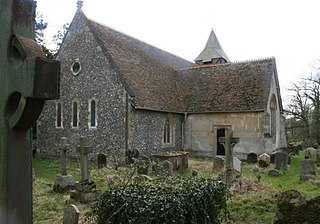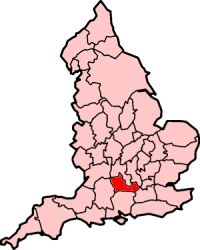Related Research Articles

Reading is a town and borough in Berkshire, England. Most of its built-up area lies within the Borough of Reading, although some outer suburbs are parts of neighbouring local authority areas. Located in the Thames Valley at the confluence of the rivers Thames and Kennet, Reading is 40 miles (64 km) east of Swindon, 25 miles (40 km) south of Oxford, 40 miles (64 km) west of London and 16 miles (26 km) north of Basingstoke.

Reading Abbey is a large, ruined abbey in the centre of the town of Reading, in the English county of Berkshire. It was founded by Henry I in 1121 "for the salvation of my soul, and the souls of King William, my father, and of King William, my brother, and Queen Maud, my wife, and all my ancestors and successors." In its heyday the abbey was one of Europe's largest royal monasteries. The traditions of the Abbey are continued today by the neighbouring St James's Church, which is partly built using stones of the Abbey ruins.

Swallowfield is a village and civil parish in the Wokingham district, in Berkshire, England, about 5 miles (8 km) south of Reading, and 1 mile (1.6 km) north of the county boundary with Hampshire. The civil parish of Swallowfield also includes the nearby villages of Riseley and Farley Hill. In 2011 the parish had a population of 1971.

Sir John Mason was an English diplomat and spy.

Shinfield is a village and civil parish in the Borough of Wokingham, Berkshire, England. It lies just south of Reading, around 3 miles (4.8 km) from the town centre, and covers an area of 4,313 acres (17.45 km2). Shinfield Park is the northern part of the parish, becoming physically separated from Reading when the M4 motorway was constructed in 1971.

East Lockinge is a village and former civil parish, now in the parish of Lockinge, in the Vale of White Horse district, in the county of Oxfordshire, England. It was part of Berkshire until the 1974 local authority boundary changes transferred the Vale of White Horse to Oxfordshire. It is about 1.5 miles (2.4 km) east of Wantage, the village is included within the North Wessex Downs Area of Outstanding Natural Beauty (AONB). In 1931 the parish had a population of 227. On 1 April 1934 the parish was abolished to form "Lockinge".

Greyfriars Church is an evangelical Anglican church, and former Franciscan friary, in the town centre of Reading in the English county of Berkshire. The church forms part of the Church of England's Diocese of Oxford.

Historically, the English county of Berkshire has been bordered to the north by the ancient boundary of the River Thames. However there were major changes in 1974: the Vale of White Horse and parts of Oxfordshire south of the Thames were previously part of Berkshire, but were lost to the county in 1974. Conversely, the Slough area north of the Thames is historically part of Buckinghamshire, but became ceremonially part of Berkshire in 1974.

Grazeley is an area covering the small villages of Grazeley in the civil parish of Shinfield and Grazeley Green in the civil parish of Wokefield, 4 miles (6.4 km) south of Reading in the English county of Berkshire. To the east is the village of Spencers Wood, to the west is Wokefield and to the south is Beech Hill.

St Giles' Church is a Church of England parish church in the town of Reading in the English county of Berkshire.

St Laurence's Church is a Church of England mission and former parish church in the town of Reading in the English county of Berkshire. It is situated alongside the site of Reading Abbey, formerly bounded by the main Compter Gate to the south and the Hospitium of St John to the north. What was once the private chapel of the latter institution still remains in the north aisle. The church is a Grade I listed building.

The Flag of Berkshire is the flag of the historic county of Berkshire in England. The flag was registered with the Flag Institute as the flag of the county in March 2017. The flag was adopted after the design was submitted by a number of county-based bodies as well as the Lord Lieutenant of the county. Prior to adoption, a banner of the arms of the former Berkshire County Council had been occasionally used to represent the county.

The Abbey Gateway was originally the inner gateway of Reading Abbey, which today is a large, mostly ruined abbey in the center of the town of Reading, in the English county of Berkshire. The gateway adjoins Reading Crown Court and Forbury Gardens and is one of only two abbey buildings that have survived intact, the other being the Hospitium of St John the Baptist. It is a grade I listed building, and includes a porters lodge on the ground floor and a large open room above the gate.
Sir Francis Knollys of Reading Abbey, Berkshire was an English privateer and politician who sat in the House of Commons at various times between 1575 and 1648.
Occupation at the site of Reading may date back to the Roman period, possibly as either a trading port on the River Thames, or as an intersection on the Roman road connecting London with Calleva Atrebatum near Silchester.

The statue of Queen Victoria stands at the western end of Friar Street outside the Town Hall of Reading, Berkshire, in southern England.

The following is a timeline of the history of Reading, the county town of Berkshire in England.

The Hospitium of St John the Baptist was the hospitium, or dormitory for pilgrims, of Reading Abbey, which today is a large, ruined abbey in the centre of the town of Reading, in the English county of Berkshire. The hospitium was founded in 1189, and at its maximum comprised a range of buildings that could accommodate 400 people. The main building has survived, and is grade II listed. Much of the remainder of the original hospitium was located where Reading Town Hall now stands.

Bere Court is an English country house. It is a historic Grade I listed building. The house is located southwest of Pangbourne, Berkshire where it was once the manor house.
References
- ↑ Ford, David Nash (2001). "Abbots of Reading, Berkshire". Royal Berkshire History. Nash Ford Publishing. Retrieved 28 December 2010.
- ↑ Phillips, Daphne (1980). The Story of Reading. Countryside Books. p. 32. ISBN 0-905392-07-8.
- ↑ "Victoria County History: A History of the County of Berkshire, Volume 2 (Friaries: The grey friars of Reading)". pp. 89–91. Retrieved 22 July 2016.